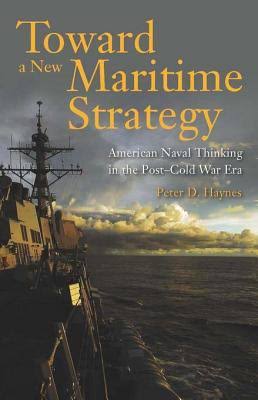Reading Room: American Naval Thinking in the Post-Cold War Era

The development of the United States’ maritime strategy remains a source of enduring fascination for naval watchers. Peter D. Haynes’ exceptional book provides insights into the various beliefs, dogmas, ideologies and motivations that animated the US Navy’s strategy as it evolved through the decades after the Cold War. An in-depth inquiry into the US Navy’s intellectual journey, the book is a useful account for anyone studying America’s maritime strategic evolution: how US naval leadership responded to the needs of the changing geopolitical environment, the strategic ends maritime power was used to accomplish and why the strategy evolved from a navy-centric operations philosophy into a truly maritime strategy, including the US Marine Corps and Coast Guard.
This is a perceptive and insightful book, meant to inform and educate. Haynes throws critical light on the US institutional approach to maritime strategy and evaluates its development, including the lively debates that marked the stages of its evolution. The author also criticises flawed aspects of maritime policies, highlighting the failings of senior naval officers and thought leaders as they went about the task of refining maritime strategy to advance specific strategic goals.
Haynes begins with US naval strategy in the initial years of the Cold War, when the navy established an unarticulated strategy of generic operational flexibility. Key to the strategy, he notes, was forward deployment, a cornerstone of US maritime doctrine and an intuitive expression of how the navy defines its purpose and identity. The navy’s contingent and implicit outlook contrasted heavily with the reductionist, explicit and rigid approach of US political strategy, which emphasised declaratory postures. To satisfy the political leadership and tackle competition from the Air Force, the navy leadership embedded policies of nuclear deterrence in war plans to emphasise the navy’s central place in national military strategy.
Haynes observes that a key problem in the post-Cold War era was the navy’s institutional culture’s indifference to new strategic thinking. In the years following the disintegration of the Soviet Union, US maritime analysts remained preoccupied with the use of force, continuing to view the navy through the lenses of deterrence and coercion. This was partly due to the Cold War experience, which institutionalised the adversary, creating an organisational culture unfriendly to the use of maritime power for law-enforcement and other benign purposes. The navy’s emphasis on deterrence continued long after the decline of the USSR, frustrating broader systemic efforts to forge a comprehensive and balanced maritime strategy.
In subsequent years, the US Navy redefined the terms of its own relevance by institutionalising the revolutionary argument that America’s vital interests lie not in the defence of territory and lives but in preserving the relationship between state power and the international political economy. The journey was fraught with challenges, above all the tussle between ‘tactical goals’ and ‘strategic policy’. Strategic theorists had implanted a way of thinking that was ‘hyper-rationalist, a-political and a-historic’, turning ‘strategy into deterrence and deterrence into an esoteric intellectual exercise’. The preoccupation with high-tech shortcuts and quick decisive tactical victory followed the US military’s belief in the rationalist tradition of Swiss military theorist Antoine-Henri Jomini, who advocated the separation of military and political goals.
The task for naval leadership was to overcome psychological hurdles in redefining maritime power as an instrument in support of land operations. The first post-Cold War strategy document in 1992 highlighted naval force as a tool of influence, deterrence and littoral dominance. Though forward-looking, this strategy was soon replaced by emphasis upon presence and cross-spectrum enabling capabilities, reinterpreting naval power as a tool of foreign policy.
In the 2000s, the political leadership goaded naval leaders to focus attention on influencing events ashore in support of geopolitical objectives. Much talk in this time centred on interlocking dependencies that made the highly globalised US economy vulnerable to crisis and conflict overseas. The thrust of the navy’s efforts in those years was on developing the ways and means to tackle regional anti-access and area-denial strategies.
Haynes suggests that the move towards a truly cooperative and integrated strategy began in 2005 when Admiral Mike Mullen took charge as Chief of Naval Operations. In a document signed by President Bush that year, Mullen’s team of strategists underscored the relationship between sea-power, national maritime security and global prosperity.
Haynes’ portrayal of American naval culture will resonate with many naval officers familiar with the challenges of doctrine formation and strategic planning. The depiction of essential divisions within the US naval community in the post-Cold War years is moreover an allegory for modern day disjunctions in strategic thought elsewhere.
An interesting narration of the US Navy’s fascinating institutional history, Haynes’ book is recommended reading for maritime scholars and strategic planners. It is a long, winding and somewhat clunky story but a compelling read with a message that is both instructive and inspirational.
Peter D. Haynes, Toward a New Maritime Strategy: American Naval Thinking in the Post-Cold War Era, Naval Institute Press, 2015.
Abhijit Singh is Senior Fellow and Head of Maritime Policy Initiative at the Observer Research Foundation (ORF) in New Delhi. A former Indian naval officer, he was involved in the drafting of the Indian navy’s maritime strategy document “Freedom of the Seas” in 2007.





